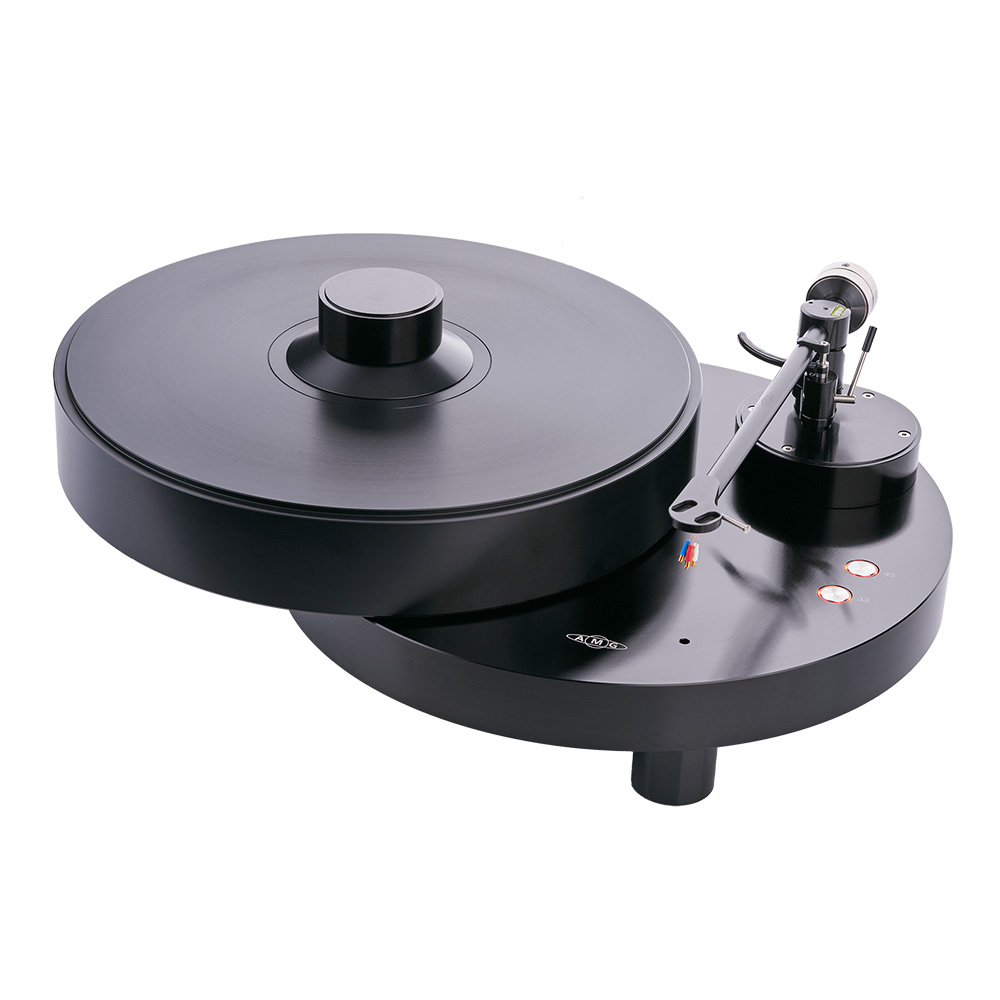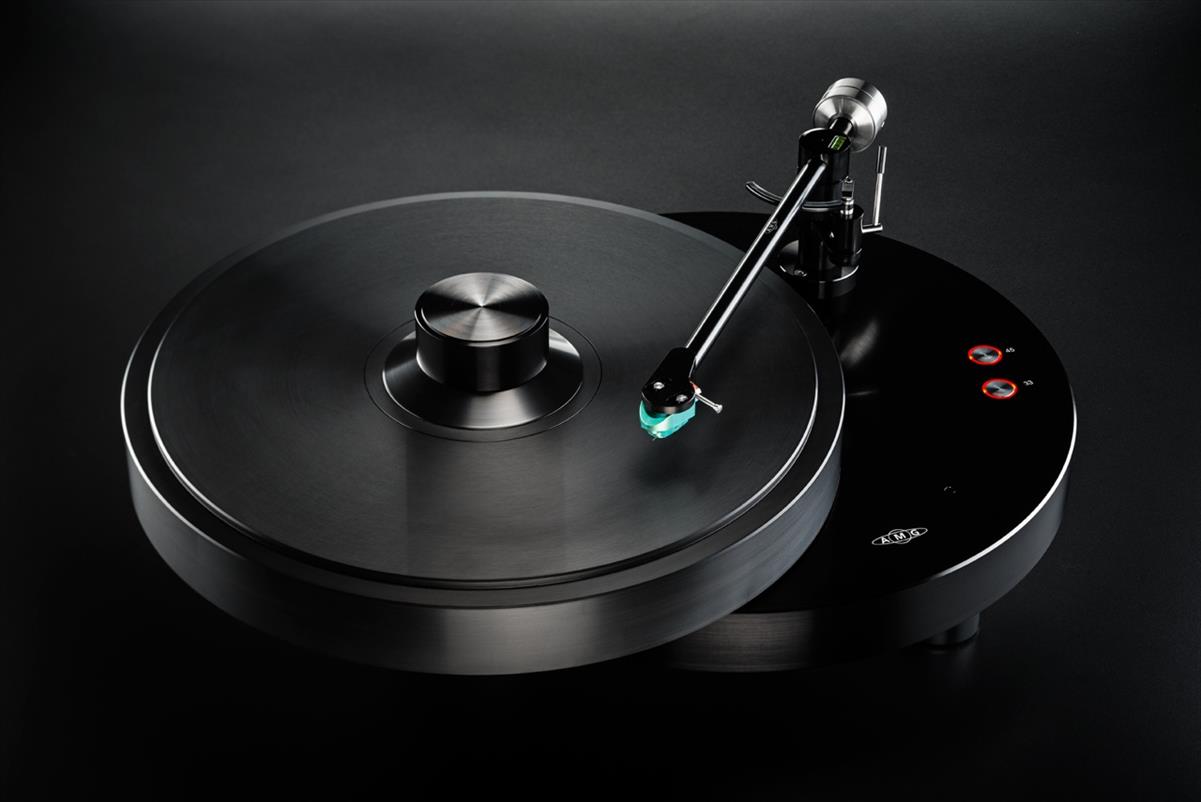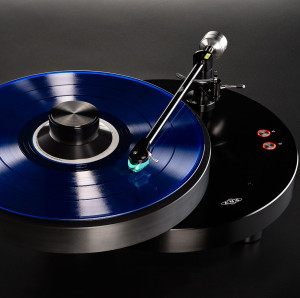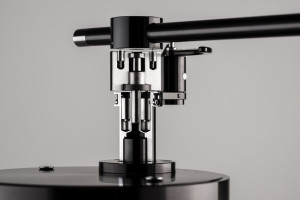The platter mass, which has been increased to 5.6 kg, together with the newly developed platter-subplater interface, ensure significantly improved speed stability resulting in a more realistic and engaging musical presentation.
The belt drive system has been optimized, contributing to these sonic improvements. The ultra-quiet Swiss drive motor now runs in a more-ideal speed range, and has been equipped with new damping elements ensuring that it operates almost silently.
In the platter bearing, manufacturing tolerances have been optimised to micrometer-range of accuracy, and the newly added tonearm base can now be fitted with a wider range of tonearms.
In addition to the aesthetic design, the extremely convenient operation via capacitive touch buttons has been retained. Fine adjustment of the speeds 33 and 45 can also be carried out completely without tools.
Standard AMG features such as the decoupled spindle/bearing construction, high-precision manufacturing, and the visible and tangible material and workmanship quality have not been forgotten in this elegant new turntable.
'
AMG Giro MK II turntable Page 2
All the turntable and arm's adjustments are smooth, precise, and easy, but because you'll need some equipment and experience to do it properly, installing and calibrating a cartridge on the 9W2 isn't a job for beginners.
The Giro MK II is a solid design, with no springs or other decoupling from its environment, so the supporting surface is important. I tried it first on one of my trusty IKEA Aptitlig butcher block supports but found the bamboo a bit underdamped, resulting in a slight loss of focus and precision in the sound. A Zoethecus Z-Slab support proved better; its constrained-layer damping brought the sound into sharper relief. I have often seen the AMGs on HRS platforms, which add some compliant isolation, but I didn't have one available.
For most of my listening, I paired the SLR Gullwing cartridge with a Parasound JC 3 Jr. phono preamp, which has adjustability that makes it easy to optimize the match with just about any cartridge. I tried the Sutherland Little Loco, but the Benz's highish 40 ohm impedance was too high for the Loco's current-drive input (footnote 1).
Listening
I tend to think of a hi-fi system as a musical time machine, allowing me to enjoy performances from distant times and places when I can't be there. As such, I tend to be less concerned about the specific sound of something than I am with its ability to let me hear through the recording to the essence of the performance. I want to know what kind of mood the performers were in—happy, sad, depressed, joyful, nervous—and such emotions should be heard despite the qualities of the recording. As your system becomes more capable, it should be able to extract an enjoyable musical experience from an ever-expanding range of records of varying quality as opposed to whittling down your playlist to a few carefully selected sonic spectaculars.
How is that achieved? I put much weight on a component's ability to unravel a dense recording, putting everything in its place and allowing your brain to make sense out of chaos so you understand why someone felt that recording was worthy of release. My decades-long appreciation of the original Quad Electrostatic speaker reflects this approach perfectly. While I recognize its real and often quite severe limitations in several sonic areas, few other speakers I've heard give me as direct a line to the music-making as they do. (Besides, I live in a New York City apartment, with neighbors. If my system could play as loud, deep, and dynamically as The Allman Brothers Band at The Fillmore East in 1971, I'd soon be out on my ass.)

How does the Giro MK II fare under such scrutiny? To find out, I started by playing—not the Allman Brothers but Ira Sullivan's eponymous 1977 album (Flying Fish FF-075), an intimate, almost claustrophobic studio recording that places the instruments in stark relief against a dark audio canvas. Pianist Jodie Christian switches between acoustic and electric piano from song to song; on both instruments, the Giro was able to combine tonal richness with the solidity you get from piano chords when there's no insecurity or waffling about pitch. Sullivan, too, plays several instruments, and from the purity of his flugelhorn tone to the shimmer of his flute, the richness of the Giro/Benz combination's tonal palette and the resulting sonic contrast between the various instruments made for real ear candy.

Lou Reed must have been an audiophile of some sort, even if many of his recordings don't give that impression. About 30 years ago, Lou became interested in the sonic properties of audio cables and sent someone to the high-end audio store I worked at to have a custom wiring loom made for his guitar amp rack. The problem was, he wanted it to use Monster M1000 interconnect wire, a pig of a cable to terminate. I spent three days working on that one, and I didn't even get to meet Lou!
Regardless of how that turned out, Lou's 1982 album The Blue Mask (RCA Victor AFL1-4221) has always been a favorite, with various references in the lyrics to our shared alma mater, Syracuse University. Like many of Lou's albums, The Blue Mask can be dark- and thick-sounding on the wrong system, but on the Giro/Benz system, it was easy to enjoy the music without being distracted by the recording. For me, the standout performer on this album is Fernando Saunders, whose agile, melodic basslines make his contributions sound more like a lead instrument than rhythmic foundation. The Giro made it easy to pull his sound out of the mix, allowing me to focus on his role in the sound of the band. Even on the deliberately loud, aggressive-sounding title track, nothing got swamped or buried.
Switching gears, I pulled out a 1973 live recording of the Concentus Musicus Wien playing Vivaldi's Oboe Concerto No.3 in G minor (Telefunken SAW 9626-M). Recorded in a church in The Netherlands, this recording has an extraordinary mix of ambience and detail, which the Giro had no problem unraveling. Despite being an early-instrument performance, the strings were brightly illuminated, with plenty of bite, and the oboe was crystal-clear and dynamic. Surrounding it all and supporting the sonic picture was the massive acoustics of the church. In contrast to most live recordings made today, the Telefunken engineers did little to suppress noises from the audience: Between movements, you can hear people way back deep in the church coughing and shuffling.
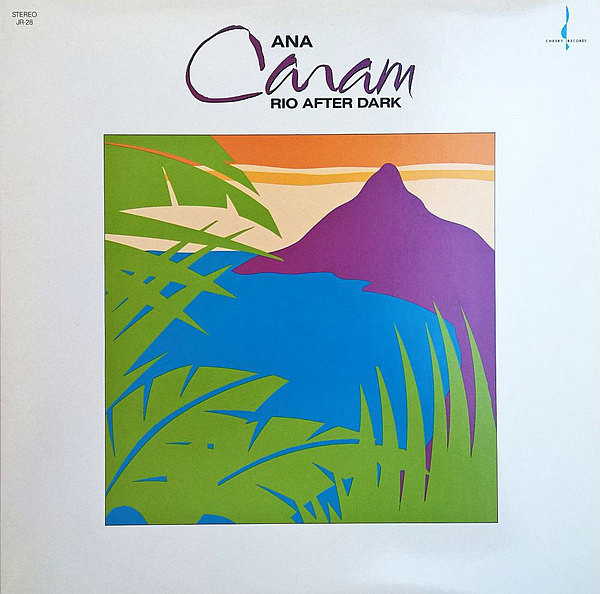
I like to listen to "normal"—not hi-fi—recordings of extraordinary music, but there's no harm in pulling out an audiophile chestnut and giving it a spin. It's hard to believe that Brazilian singer/guitarist Ana Caram's album Rio After Dark was recorded more than a third of a century ago. It holds up, even for me, and I've heard it in hundreds of audio demonstrations. The original vinyl release was mastered by the late Tim de Paravicini at The Exchange, a facility he built with John Dent in London. The results via the Giro are exceptional; Ana's voice and guitar sit slightly left of center, reproduced with striking tonal clarity. On the track "Viola Fora De Moda," percussionists Cafe and Carlos Alberto De Oliveira move up front and play every percussion device they could muster, generating a huge soundstage that will test the resolution of your system. The Giro was able to dig out this intense level of detail without muddling the sound or glossing over details.
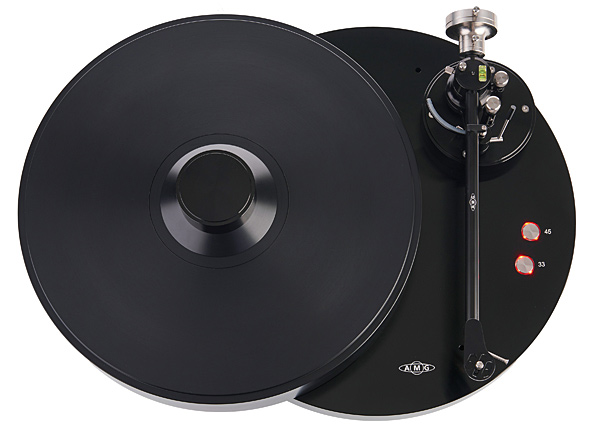
Conclusion
While it may not be a Mercedes, the AMG Giro MK II turntable with the Benz Micro SLR Gullwing cartridge proved that another type of machine is capable of transporting you to wonderful, beautiful places. The elegance of the Giro's design shows that a high-end turntable doesn't need to look like someone's junior high school science-fair project to be capable of creating beautiful music.
Five years ago, in his review of the original Giro, Herb Reichert wrote, "the AMG seems to have it all going on: exquisite style, superb build quality, ease of setup, ease of use, and the ability to steer cartridges and play records with the world's finest record players." All those observations apply to the MK II version, but now it can accommodate a wider variety of tonearms. Plus, even more than before, while it may look like a svelte supermodel, it can ball with the big boys.

